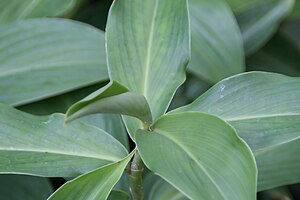Note: This is a project under development. The articles on this wiki are just being initiated and broadly incomplete. You can Help creating new pages.
Curcuma zedoaria
Curcuma zeodaria is a herbaceous, perennial plant. Each pseudostem comprises around 5 leaves with blades around 35cm long and 13cm wide.
Contents
[hide]- 1 Uses
- 2 Parts Used
- 3 Chemical Composition
- 4 Common names
- 5 Properties
- 6 Habit
- 7 Identification
- 8 List of Ayurvedic medicine in which the herb is used
- 9 Where to get the saplings
- 10 Mode of Propagation
- 11 How to plant/cultivate
- 12 Commonly seen growing in areas
- 13 Photo Gallery
- 14 References
- 15 External Links
Uses
Indigestion, Nausea, Flatulence, Bloating, Cervical cancer, Bad breath, Ulcers, Wounds, Skin disorders, Scabies, Eczema, Vomiting[1]
Parts Used
Rhizome, Root, Whole plant.[1]
Chemical Composition
Many of the biological activities of Curcuma species can be attributed to nonvolatile curcuminoids, but these plants also produce volatile chemicals. Essential oils, in general, have shown numerous beneficial effects for health maintenance and treatment of diseases.[2]
Common names
| Language | Common name |
|---|---|
| Kannada | Kadu Arisina, Kachora |
| Hindi | Kachuru, Kaalihaldi |
| Malayalam | Kachoori kilannu, Kuva |
| Tamil | Kichchili Kilangu |
| Telugu | Kachoram |
| Marathi | NA |
| Gujarathi | NA |
| Punjabi | NA |
| Kashmiri | NA |
| Sanskrit | Gandhamooli, Karchoora |
| English | Zeedore |
Properties
Reference: Dravya - Substance, Rasa - Taste, Guna - Qualities, Veerya - Potency, Vipaka - Post-digesion effect, Karma - Pharmacological activity, Prabhava - Therepeutics.
Dravya
Rasa
Guna
Veerya
Vipaka
Karma
Prabhava
Habit
Identification
Leaf
| Kind | Shape | Feature |
|---|---|---|
| Leaves are large | Reaching upto 1 m in length | Oblong and deeply veined, often coloured purplish in the centre |
Flower
| Type | Size | Color and composition | Stamen | More information |
|---|---|---|---|---|
| Funnel-shaped | Whitish or pale-yellow | Calyx is whitish and obtusely toothed. | Flowering from March to April |
Fruit
| Type | Size | Mass | Appearance | Seeds | More information |
|---|---|---|---|---|---|
| Fruiting from March to April |
Other features
List of Ayurvedic medicine in which the herb is used
Amritapraasha, Amrita Ballataki, Dashamoolarishta, Balashvagandha Taila, Madanakameshwari Taila, Mahadrakshadi Churna, Sarivadyarishta, Sugandha Tailam, Soubhagya Shunti.[1]
Where to get the saplings
Mode of Propagation
How to plant/cultivate
A plant of the hot, humid, lowland tropics, where it is found at elevations up to 900 metres.[4]
Commonly seen growing in areas
Photo Gallery
References
- ↑ Jump up to: 1.0 1.1 1.2 ”Karnataka Medicinal Plants Volume - 2” by Dr.M. R. Gurudeva, Page No.177, Published by Divyachandra Prakashana, #45, Paapannana Tota, 1st Main road, Basaveshwara Nagara, Bengaluru.
- Jump up ↑ Article - Chemical Composition and Biological Activities of Essential Oils of Curcuma Species by Aromatic Plant Research Center, 230 N 1200 E, Suite 102, Lehi, UT 84043, USA.
- Jump up ↑ Vikaspedia
- Jump up ↑ Useful tropical plant by The ferns.information
External Links
- Ayurvedic Herbs known to be helpful to treat Indigestion
- Ayurvedic Herbs known to be helpful to treat Nausea
- Ayurvedic Herbs known to be helpful to treat Flatulence
- Ayurvedic Herbs known to be helpful to treat Bloating
- Ayurvedic Herbs known to be helpful to treat Cervical cancer
- Ayurvedic Herbs known to be helpful to treat Bad breath
- Ayurvedic Herbs known to be helpful to treat Ulcers
- Ayurvedic Herbs known to be helpful to treat Wounds
- Ayurvedic Herbs known to be helpful to treat Skin disorders
- Ayurvedic Herbs known to be helpful to treat Scabies
- Ayurvedic Herbs known to be helpful to treat Eczema
- Ayurvedic Herbs known to be helpful to treat Vomiting
- Herbs with Rhizome used in medicine
- Herbs with Root used in medicine
- Herbs with Whole plant used in medicine
- Herbs with common name in Kannada
- Herbs with common name in Hindi
- Herbs with common name in Malayalam
- Herbs with common name in Tamil
- Herbs with common name in Telugu
- Herbs with common name in Sanskrit
- Herbs with common name in English
- Habit - Perennial
- Index of Plants which can be propagated by Seeds
- Index of Plants which can be propagated by Division of rhizome
- Herbs that are commonly seen in the region of Damp
- Herbs that are commonly seen in the region of Deciduous forests
- Herbs
- Pages without herbs images




